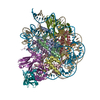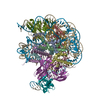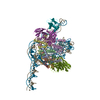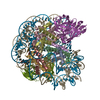+ データを開く
データを開く
- 基本情報
基本情報
| 登録情報 | データベース: PDB / ID: 8evh | ||||||
|---|---|---|---|---|---|---|---|
| タイトル | CX3CR1 nucleosome and wild type PU.1 complex | ||||||
 要素 要素 |
| ||||||
 キーワード キーワード | TRANSCRIPTION/DNA /  nucleosome (ヌクレオソーム) / nucleosome (ヌクレオソーム) /  transcription factor (転写因子) / transcription factor (転写因子) /  transcription (転写 (生物学)) / chromatin binding protein-DNA complex / DNA BINDING PROTEIN-DNA complex / TRANSCRIPTION-DNA complex transcription (転写 (生物学)) / chromatin binding protein-DNA complex / DNA BINDING PROTEIN-DNA complex / TRANSCRIPTION-DNA complex | ||||||
| 機能・相同性 |  機能・相同性情報 機能・相同性情報positive regulation of myeloid dendritic cell chemotaxis / anatomical structure regression / follicular B cell differentiation / positive regulation of antifungal innate immune response / regulation of myeloid progenitor cell differentiation / pro-T cell differentiation / negative regulation of neutrophil degranulation / germinal center B cell differentiation / positive regulation of microglial cell mediated cytotoxicity / myeloid leukocyte differentiation ...positive regulation of myeloid dendritic cell chemotaxis / anatomical structure regression / follicular B cell differentiation / positive regulation of antifungal innate immune response / regulation of myeloid progenitor cell differentiation / pro-T cell differentiation / negative regulation of neutrophil degranulation / germinal center B cell differentiation / positive regulation of microglial cell mediated cytotoxicity / myeloid leukocyte differentiation / granulocyte differentiation / TRAIL-activated apoptotic signaling pathway / apoptotic process involved in blood vessel morphogenesis / lymphocyte differentiation / endothelial to hematopoietic transition / negative regulation of adipose tissue development / pericyte cell differentiation / negative regulation of MHC class II biosynthetic process / immature B cell differentiation / lymphoid progenitor cell differentiation / myeloid dendritic cell differentiation / defense response to tumor cell / vasculature development / regulation of DNA-binding transcription factor activity / negative regulation of non-canonical NF-kappaB signal transduction / oncogene-induced cell senescence / negative regulation of protein localization to chromatin / positive regulation of p38MAPK cascade / positive regulation of B cell differentiation / DNA-binding transcription repressor activity / STAT family protein binding / DNA-binding transcription activator activity / interleukin-6-mediated signaling pathway /  NFAT protein binding / somatic stem cell population maintenance / macrophage differentiation / negative regulation of megakaryocyte differentiation / protein localization to CENP-A containing chromatin / cis-regulatory region sequence-specific DNA binding / Chromatin modifying enzymes / Replacement of protamines by nucleosomes in the male pronucleus / CENP-A containing nucleosome / epigenetic regulation of gene expression / Packaging Of Telomere Ends / Recognition and association of DNA glycosylase with site containing an affected purine / Cleavage of the damaged purine / Deposition of new CENPA-containing nucleosomes at the centromere / lipopolysaccharide-mediated signaling pathway / transcription initiation-coupled chromatin remodeling / Recognition and association of DNA glycosylase with site containing an affected pyrimidine / Cleavage of the damaged pyrimidine / Inhibition of DNA recombination at telomere / Meiotic synapsis / telomere organization / RNA Polymerase I Promoter Opening / Interleukin-7 signaling / Assembly of the ORC complex at the origin of replication / SUMOylation of chromatin organization proteins / NFAT protein binding / somatic stem cell population maintenance / macrophage differentiation / negative regulation of megakaryocyte differentiation / protein localization to CENP-A containing chromatin / cis-regulatory region sequence-specific DNA binding / Chromatin modifying enzymes / Replacement of protamines by nucleosomes in the male pronucleus / CENP-A containing nucleosome / epigenetic regulation of gene expression / Packaging Of Telomere Ends / Recognition and association of DNA glycosylase with site containing an affected purine / Cleavage of the damaged purine / Deposition of new CENPA-containing nucleosomes at the centromere / lipopolysaccharide-mediated signaling pathway / transcription initiation-coupled chromatin remodeling / Recognition and association of DNA glycosylase with site containing an affected pyrimidine / Cleavage of the damaged pyrimidine / Inhibition of DNA recombination at telomere / Meiotic synapsis / telomere organization / RNA Polymerase I Promoter Opening / Interleukin-7 signaling / Assembly of the ORC complex at the origin of replication / SUMOylation of chromatin organization proteins /  DNAメチル化 / transforming growth factor beta receptor signaling pathway / DNAメチル化 / transforming growth factor beta receptor signaling pathway /  赤血球形成 / protein sequestering activity / Condensation of Prophase Chromosomes / ERCC6 (CSB) and EHMT2 (G9a) positively regulate rRNA expression / Chromatin modifications during the maternal to zygotic transition (MZT) / SIRT1 negatively regulates rRNA expression / HCMV Late Events / 赤血球形成 / protein sequestering activity / Condensation of Prophase Chromosomes / ERCC6 (CSB) and EHMT2 (G9a) positively regulate rRNA expression / Chromatin modifications during the maternal to zygotic transition (MZT) / SIRT1 negatively regulates rRNA expression / HCMV Late Events /  innate immune response in mucosa / PRC2 methylates histones and DNA / Defective pyroptosis / HDACs deacetylate histones / RNA Polymerase I Promoter Escape / Nonhomologous End-Joining (NHEJ) / Transcriptional regulation by small RNAs / Formation of the beta-catenin:TCF transactivating complex / RUNX1 regulates genes involved in megakaryocyte differentiation and platelet function / Activated PKN1 stimulates transcription of AR (androgen receptor) regulated genes KLK2 and KLK3 / NoRC negatively regulates rRNA expression / B-WICH complex positively regulates rRNA expression / G2/M DNA damage checkpoint / HDMs demethylate histones / innate immune response in mucosa / PRC2 methylates histones and DNA / Defective pyroptosis / HDACs deacetylate histones / RNA Polymerase I Promoter Escape / Nonhomologous End-Joining (NHEJ) / Transcriptional regulation by small RNAs / Formation of the beta-catenin:TCF transactivating complex / RUNX1 regulates genes involved in megakaryocyte differentiation and platelet function / Activated PKN1 stimulates transcription of AR (androgen receptor) regulated genes KLK2 and KLK3 / NoRC negatively regulates rRNA expression / B-WICH complex positively regulates rRNA expression / G2/M DNA damage checkpoint / HDMs demethylate histones /  regulation of erythrocyte differentiation / DNA Damage/Telomere Stress Induced Senescence / Metalloprotease DUBs / PKMTs methylate histone lysines / RMTs methylate histone arginines / regulation of erythrocyte differentiation / DNA Damage/Telomere Stress Induced Senescence / Metalloprotease DUBs / PKMTs methylate histone lysines / RMTs methylate histone arginines /  遺伝的組換え / Pre-NOTCH Transcription and Translation / DNA-binding transcription repressor activity, RNA polymerase II-specific / 遺伝的組換え / Pre-NOTCH Transcription and Translation / DNA-binding transcription repressor activity, RNA polymerase II-specific /  nucleosome assembly / positive regulation of miRNA transcription / Activation of anterior HOX genes in hindbrain development during early embryogenesis / HCMV Early Events / Transcriptional regulation of granulopoiesis / nucleosome assembly / positive regulation of miRNA transcription / Activation of anterior HOX genes in hindbrain development during early embryogenesis / HCMV Early Events / Transcriptional regulation of granulopoiesis /  histone deacetylase binding / structural constituent of chromatin / UCH proteinases / histone deacetylase binding / structural constituent of chromatin / UCH proteinases /  ヌクレオソーム / antimicrobial humoral immune response mediated by antimicrobial peptide / Recruitment and ATM-mediated phosphorylation of repair and signaling proteins at DNA double strand breaks ヌクレオソーム / antimicrobial humoral immune response mediated by antimicrobial peptide / Recruitment and ATM-mediated phosphorylation of repair and signaling proteins at DNA double strand breaks類似検索 - 分子機能 | ||||||
| 生物種 |   Homo sapiens (ヒト) Homo sapiens (ヒト)  Escherichia coli (大腸菌) Escherichia coli (大腸菌)  Mus musculus (ハツカネズミ) Mus musculus (ハツカネズミ) | ||||||
| 手法 |  電子顕微鏡法 / 電子顕微鏡法 /  単粒子再構成法 / 単粒子再構成法 /  クライオ電子顕微鏡法 / 解像度: 2.85 Å クライオ電子顕微鏡法 / 解像度: 2.85 Å | ||||||
 データ登録者 データ登録者 | Lian, T. / Guan, R. / Bai, Y. | ||||||
| 資金援助 |  米国, 1件 米国, 1件
| ||||||
 引用 引用 |  ジャーナル: Nat Struct Mol Biol / 年: 2024 ジャーナル: Nat Struct Mol Biol / 年: 2024タイトル: Structural mechanism of synergistic targeting of the CX3CR1 nucleosome by PU.1 and C/EBPα. 著者: Tengfei Lian / Ruifang Guan / Bing-Rui Zhou / Yawen Bai /  要旨: Pioneer transcription factors are vital for cell fate changes. PU.1 and C/EBPα work together to regulate hematopoietic stem cell differentiation. However, how they recognize in vivo nucleosomal DNA ...Pioneer transcription factors are vital for cell fate changes. PU.1 and C/EBPα work together to regulate hematopoietic stem cell differentiation. However, how they recognize in vivo nucleosomal DNA targets remains elusive. Here we report the structures of the nucleosome containing the mouse genomic CX3CR1 enhancer DNA and its complexes with PU.1 alone and with both PU.1 and the C/EBPα DNA binding domain. Our structures reveal that PU.1 binds the DNA motif at the exit linker, shifting 17 bp of DNA into the core region through interactions with H2A, unwrapping ~20 bp of nucleosomal DNA. C/EBPα binding, aided by PU.1's repositioning, unwraps ~25 bp of entry DNA. The PU.1 Q218H mutation, linked to acute myeloid leukemia, disrupts PU.1-H2A interactions. PU.1 and C/EBPα jointly displace linker histone H1 and open the H1-condensed nucleosome array. Our study unveils how two pioneer factors can work cooperatively to open closed chromatin by altering DNA positioning in the nucleosome. | ||||||
| 履歴 |
|
- 構造の表示
構造の表示
| 構造ビューア | 分子:  Molmil Molmil Jmol/JSmol Jmol/JSmol |
|---|
- ダウンロードとリンク
ダウンロードとリンク
- ダウンロード
ダウンロード
| PDBx/mmCIF形式 |  8evh.cif.gz 8evh.cif.gz | 417 KB | 表示 |  PDBx/mmCIF形式 PDBx/mmCIF形式 |
|---|---|---|---|---|
| PDB形式 |  pdb8evh.ent.gz pdb8evh.ent.gz | 320.1 KB | 表示 |  PDB形式 PDB形式 |
| PDBx/mmJSON形式 |  8evh.json.gz 8evh.json.gz | ツリー表示 |  PDBx/mmJSON形式 PDBx/mmJSON形式 | |
| その他 |  その他のダウンロード その他のダウンロード |
-検証レポート
| アーカイブディレクトリ |  https://data.pdbj.org/pub/pdb/validation_reports/ev/8evh https://data.pdbj.org/pub/pdb/validation_reports/ev/8evh ftp://data.pdbj.org/pub/pdb/validation_reports/ev/8evh ftp://data.pdbj.org/pub/pdb/validation_reports/ev/8evh | HTTPS FTP |
|---|
-関連構造データ
- リンク
リンク
- 集合体
集合体
| 登録構造単位 | 
|
|---|---|
| 1 |
|
- 要素
要素
-タンパク質 , 5種, 9分子 AEBFCGDHO
| #1: タンパク質 |  ヒストンH3 / Histone H3/a / Histone H3/b / Histone H3/c / Histone H3/d / Histone H3/f / Histone H3/h / Histone ...Histone H3/a / Histone H3/b / Histone H3/c / Histone H3/d / Histone H3/f / Histone H3/h / Histone H3/i / Histone H3/j / Histone H3/k / Histone H3/l ヒストンH3 / Histone H3/a / Histone H3/b / Histone H3/c / Histone H3/d / Histone H3/f / Histone H3/h / Histone ...Histone H3/a / Histone H3/b / Histone H3/c / Histone H3/d / Histone H3/f / Histone H3/h / Histone H3/i / Histone H3/j / Histone H3/k / Histone H3/l分子量: 15437.167 Da / 分子数: 2 / 由来タイプ: 組換発現 / 由来: (組換発現)   Homo sapiens (ヒト) Homo sapiens (ヒト)遺伝子: H3C1, H3FA, HIST1H3A, H3C2, H3FL, HIST1H3B, H3C3, H3FC HIST1H3C, H3C4, H3FB, HIST1H3D, H3C6, H3FD, HIST1H3E, H3C7, H3FI, HIST1H3F, H3C8, H3FH, HIST1H3G, H3C10, H3FK, HIST1H3H, H3C11, H3FF, ...遺伝子: H3C1, H3FA, HIST1H3A, H3C2, H3FL, HIST1H3B, H3C3, H3FC HIST1H3C, H3C4, H3FB, HIST1H3D, H3C6, H3FD, HIST1H3E, H3C7, H3FI, HIST1H3F, H3C8, H3FH, HIST1H3G, H3C10, H3FK, HIST1H3H, H3C11, H3FF, HIST1H3I, H3C12, H3FJ, HIST1H3J 発現宿主:   Escherichia coli 'BL21-Gold(DE3)pLysS AG' (大腸菌) Escherichia coli 'BL21-Gold(DE3)pLysS AG' (大腸菌)参照: UniProt: P68431 #2: タンパク質 |  ヒストンH4 ヒストンH4分子量: 11394.426 Da / 分子数: 2 / 由来タイプ: 組換発現 / 由来: (組換発現)   Homo sapiens (ヒト) Homo sapiens (ヒト)遺伝子: HIST1H4A, H4/A, H4FA, HIST1H4B, H4/I, H4FI, HIST1H4C, H4/G, H4FG, HIST1H4D, H4/B, H4FB, HIST1H4E, H4/J, H4FJ, HIST1H4F, H4/C, H4FC, HIST1H4H, H4/H, H4FH, HIST1H4I, H4/M, H4FM, HIST1H4J, ...遺伝子: HIST1H4A, H4/A, H4FA, HIST1H4B, H4/I, H4FI, HIST1H4C, H4/G, H4FG, HIST1H4D, H4/B, H4FB, HIST1H4E, H4/J, H4FJ, HIST1H4F, H4/C, H4FC, HIST1H4H, H4/H, H4FH, HIST1H4I, H4/M, H4FM, HIST1H4J, H4/E, H4FE, HIST1H4K, H4/D, H4FD, HIST1H4L, H4/K, H4FK, HIST2H4A, H4/N, H4F2, H4FN, HIST2H4, HIST2H4B, H4/O, H4FO, HIST4H4 発現宿主:   Escherichia coli 'BL21-Gold(DE3)pLysS AG' (大腸菌) Escherichia coli 'BL21-Gold(DE3)pLysS AG' (大腸菌)参照: UniProt: P62805 #3: タンパク質 | 分子量: 14017.428 Da / 分子数: 2 / 由来タイプ: 組換発現 / 由来: (組換発現)   Homo sapiens (ヒト) / 遺伝子: H2AC20, H2AFQ, HIST2H2AC Homo sapiens (ヒト) / 遺伝子: H2AC20, H2AFQ, HIST2H2AC発現宿主:   Escherichia coli 'BL21-Gold(DE3)pLysS AG' (大腸菌) Escherichia coli 'BL21-Gold(DE3)pLysS AG' (大腸菌)参照: UniProt: Q16777 #4: タンパク質 | 分子量: 13951.239 Da / 分子数: 2 / 由来タイプ: 組換発現 / 由来: (組換発現)   Homo sapiens (ヒト) / 遺伝子: H2BC21, H2BFQ, HIST2H2BE Homo sapiens (ヒト) / 遺伝子: H2BC21, H2BFQ, HIST2H2BE発現宿主:   Escherichia coli 'BL21-Gold(DE3)pLysS AG' (大腸菌) Escherichia coli 'BL21-Gold(DE3)pLysS AG' (大腸菌)参照: UniProt: Q16778 #8: タンパク質 | | 分子量: 32819.750 Da / 分子数: 1 / 由来タイプ: 組換発現 / 由来: (組換発現)   Mus musculus (ハツカネズミ) / 遺伝子: Spi1, Sfpi-1, Sfpi1 Mus musculus (ハツカネズミ) / 遺伝子: Spi1, Sfpi-1, Sfpi1発現宿主:   Escherichia coli 'BL21-Gold(DE3)pLysS AG' (大腸菌) Escherichia coli 'BL21-Gold(DE3)pLysS AG' (大腸菌)参照: UniProt: P17433 |
|---|
-DNA鎖 , 2種, 2分子 IJ
| #5: DNA鎖 | 分子量: 50043.855 Da / 分子数: 1 / 由来タイプ: 合成 / 由来: (合成)   Mus musculus (ハツカネズミ) Mus musculus (ハツカネズミ) |
|---|---|
| #6: DNA鎖 | 分子量: 49965.957 Da / 分子数: 1 / 由来タイプ: 合成 / 由来: (合成)   Mus musculus (ハツカネズミ) Mus musculus (ハツカネズミ) |
-抗体 , 1種, 2分子 MN
| #7: 抗体 |  単鎖可変領域フラグメント 単鎖可変領域フラグメント分子量: 29030.146 Da / 分子数: 2 / 由来タイプ: 組換発現 / 由来: (組換発現)   Escherichia coli (大腸菌) Escherichia coli (大腸菌)発現宿主:   Escherichia coli 'BL21-Gold(DE3)pLysS AG' (大腸菌) Escherichia coli 'BL21-Gold(DE3)pLysS AG' (大腸菌) |
|---|
-実験情報
-実験
| 実験 | 手法:  電子顕微鏡法 電子顕微鏡法 |
|---|---|
| EM実験 | 試料の集合状態: PARTICLE / 3次元再構成法:  単粒子再構成法 単粒子再構成法 |
- 試料調製
試料調製
| 構成要素 | 名称: nucleosome PU.1 complex / タイプ: COMPLEX / Entity ID: all / 由来: MULTIPLE SOURCES | ||||||||||||||||
|---|---|---|---|---|---|---|---|---|---|---|---|---|---|---|---|---|---|
| 由来(天然) |
| ||||||||||||||||
| 由来(組換発現) | 生物種:   Escherichia coli 'BL21-Gold(DE3)pLysS AG' (大腸菌) Escherichia coli 'BL21-Gold(DE3)pLysS AG' (大腸菌) | ||||||||||||||||
| 緩衝液 | pH: 7.3 | ||||||||||||||||
| 試料 | 包埋: NO / シャドウイング: NO / 染色 : NO / 凍結 : NO / 凍結 : YES : YES | ||||||||||||||||
急速凍結 | 凍結剤: ETHANE |
- 電子顕微鏡撮影
電子顕微鏡撮影
| 実験機器 |  モデル: Titan Krios / 画像提供: FEI Company |
|---|---|
| 顕微鏡 | モデル: FEI TITAN KRIOS |
| 電子銃 | 電子線源 : :  FIELD EMISSION GUN / 加速電圧: 300 kV / 照射モード: SPOT SCAN FIELD EMISSION GUN / 加速電圧: 300 kV / 照射モード: SPOT SCAN |
| 電子レンズ | モード: BRIGHT FIELD Bright-field microscopy / 最大 デフォーカス(公称値): 2000 nm / 最小 デフォーカス(公称値): 1000 nm Bright-field microscopy / 最大 デフォーカス(公称値): 2000 nm / 最小 デフォーカス(公称値): 1000 nm |
| 撮影 | 電子線照射量: 53.8 e/Å2 / フィルム・検出器のモデル: GATAN K3 (6k x 4k) |
- 解析
解析
CTF補正 | タイプ: NONE |
|---|---|
3次元再構成 | 解像度: 2.85 Å / 解像度の算出法: FSC 0.143 CUT-OFF / 粒子像の数: 89583 / 対称性のタイプ: POINT |
 ムービー
ムービー コントローラー
コントローラー










 PDBj
PDBj












































